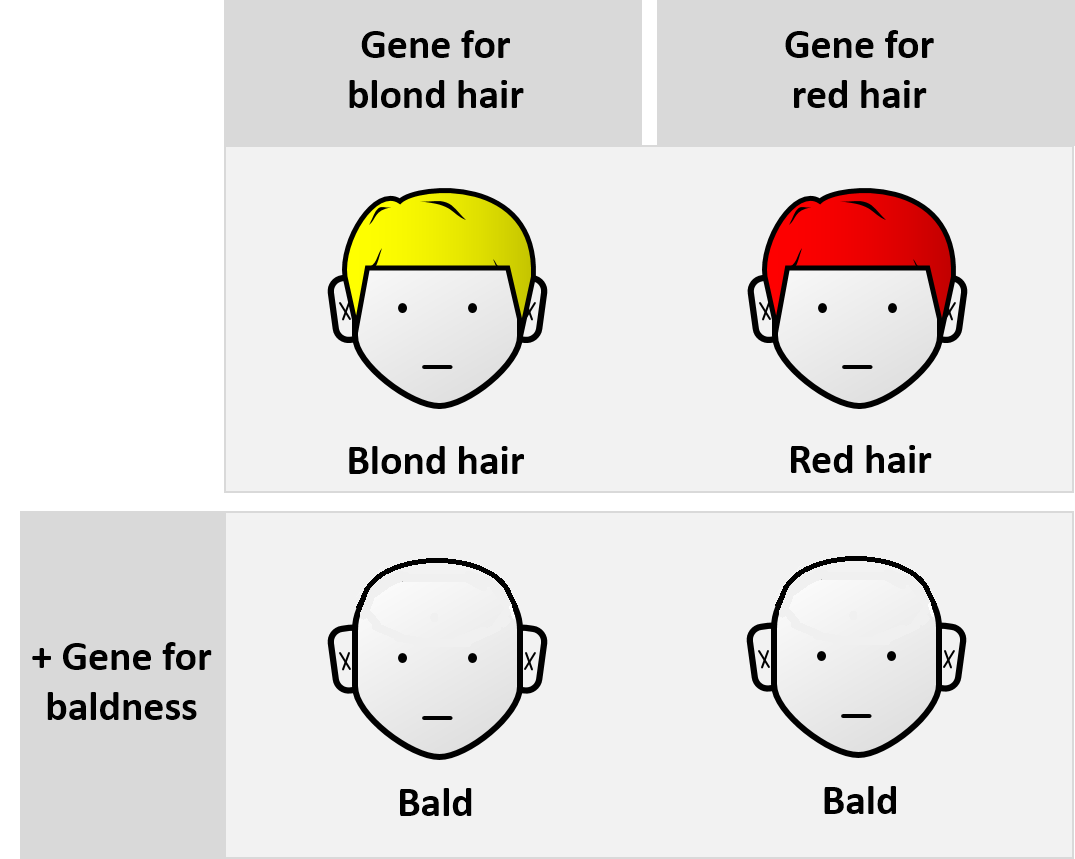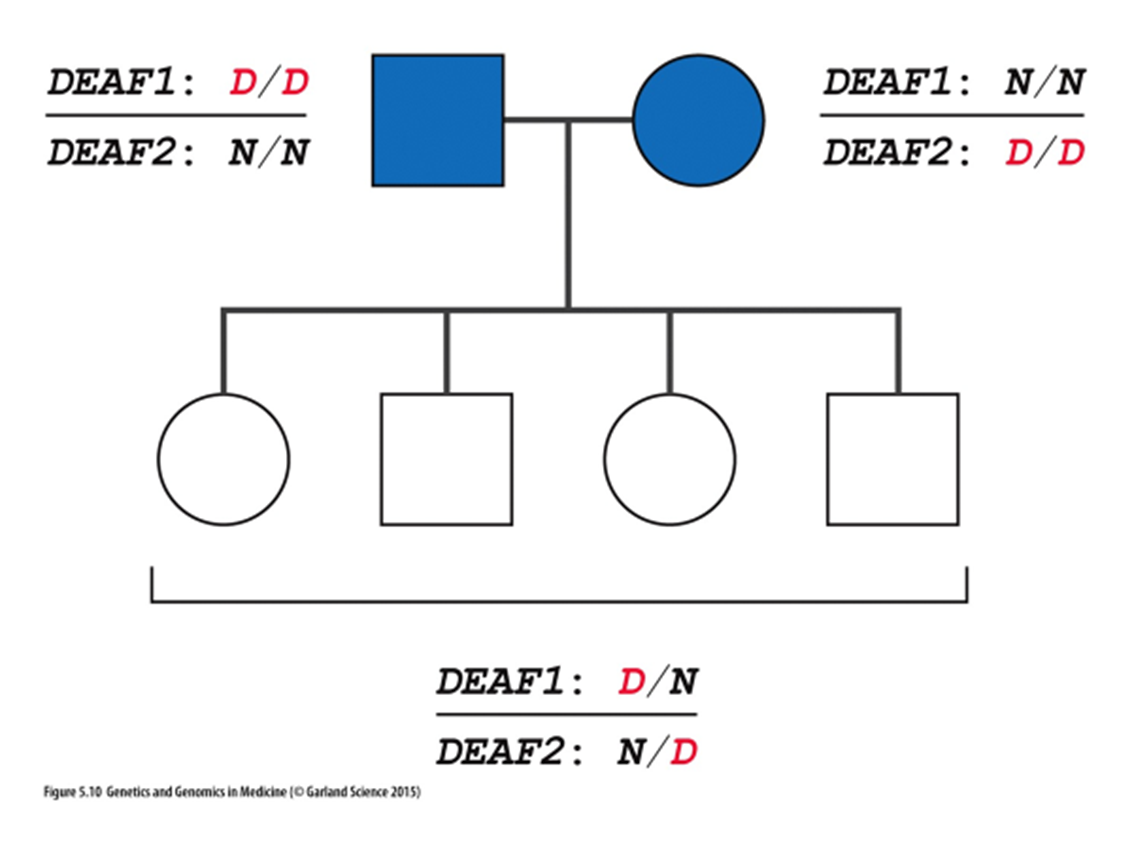Ch. 5 – Inheritance Patterns, Phenotype Variability, and Allele Frequencies.
%%What is a gene? What is the proper way to write human gene names? Do you have two alleles for every gene? Why or why not?%%
^^Gene^^: a specific sequence of DNA that encodes a particular protein
^^Allel:^^ a version of a gene (they exist in the same ==locus== (location) of a chromosome)

Human gene names:
- ALL CAPS and in italics
- example: CFTR
}}What does it mean for a trait to be mono-genic or multifactorial? What is Mendelian inheritance?}}
- 3 laws of Mendelian inheritance
- ^^Law of segregation:^^ Offspring inherit one genetic allele form each parent
- ^^The law of Independent Assortment:^^ the inheritance of one trait is not dependent on the inheritance of another
- not always the case:
- monogenic: only one gene influences the observed characteristic
- eye-color 👁️
- Multifactorial traits: multiple genes and environmental factors influence observed trait
- skin color
- ^^Law of Dominance:^^ An organism with alternate forms of a gene will express the form that is dominant
}}What does it mean for a trait to be mono-genic or multifactorial? What is Mendelian inheritance?}}
- monogenic: only one gene influences the observed characteristic
- eye-color 👁️
- Multifactorial traits: multiple genes and environmental factors influence observed trait
- skin color
- Mendelian inheritance → always monogenic
%%Dominant and recessive phenotypes are not the only phenotypes. What are some other examples?%%
- Incomplete Dominance: the phenotype of a heterozygote is intermediate between the two homozygotes
- example:
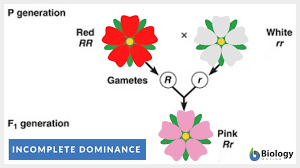
- Co-dominance: both dominant alleles contribute equally to the phenotype
- example:
- eggplant
- ABO blood group system
- Epistasis: the expression of one gene modifies the phenotype during the presence of one or more other genes
%%Be able to read and interpret which of the five basic inheritance patterns a pedigree is depicting.%%
- **Pedigrees (**stammbäume): Graphical representation of a family tree with standardized symbols
- Types:
- Autosomal dominant
- Autosomal recessive
- X-linked dominant
- X-linked recessive
- Y-linked (patrilineal)
- Mitochondrial (matrilineal)
- Vocabulary :
- Proband proposito=male proposita=female family member whom the family is first ascertained: brought to the attention of health care professionals
- Kindred Extended family covering many generations
- Sib (sibling) brother or sister
- Sibship: a series of brothers and sisters
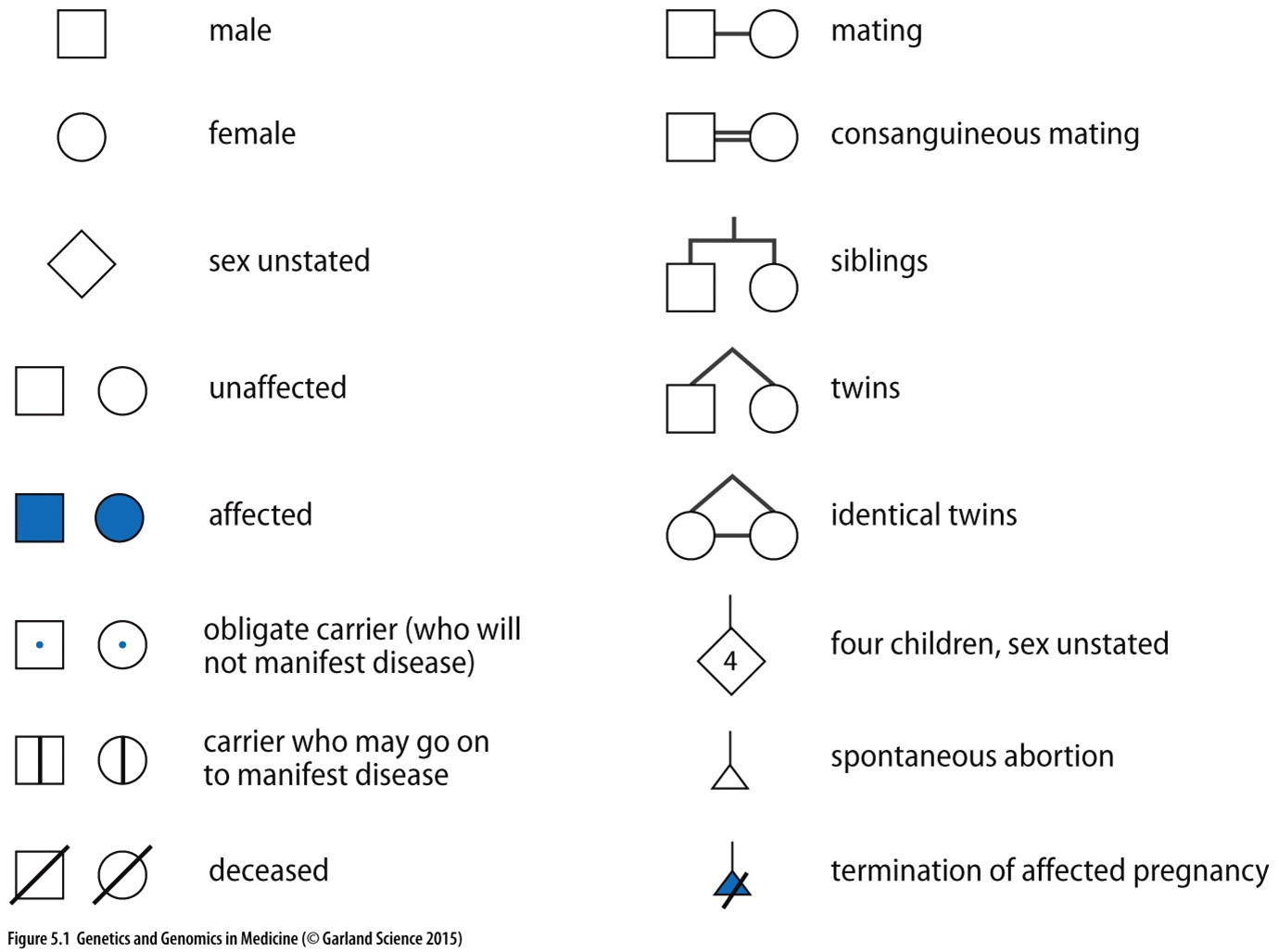
%%Be able to calculate the frequency with which autosomal dominant and recessive disorders are inherited given the carrier/affected status of parents. How do offspring of consanguineous fair?%%
%%What is consanguinity? How is the coefficient of relationship calculated?%%
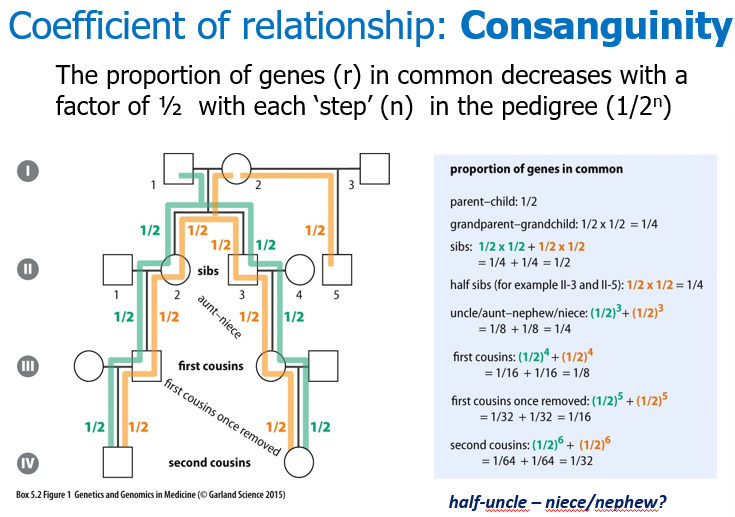
%%Explain how men are constitutionally hemizygous for most genes on the X-chromosome and women are functionally hemizygous. Why most genes and not all genes? True or False?: Males are never heterozygous for Y-linked sequences. Be able to explain.%%
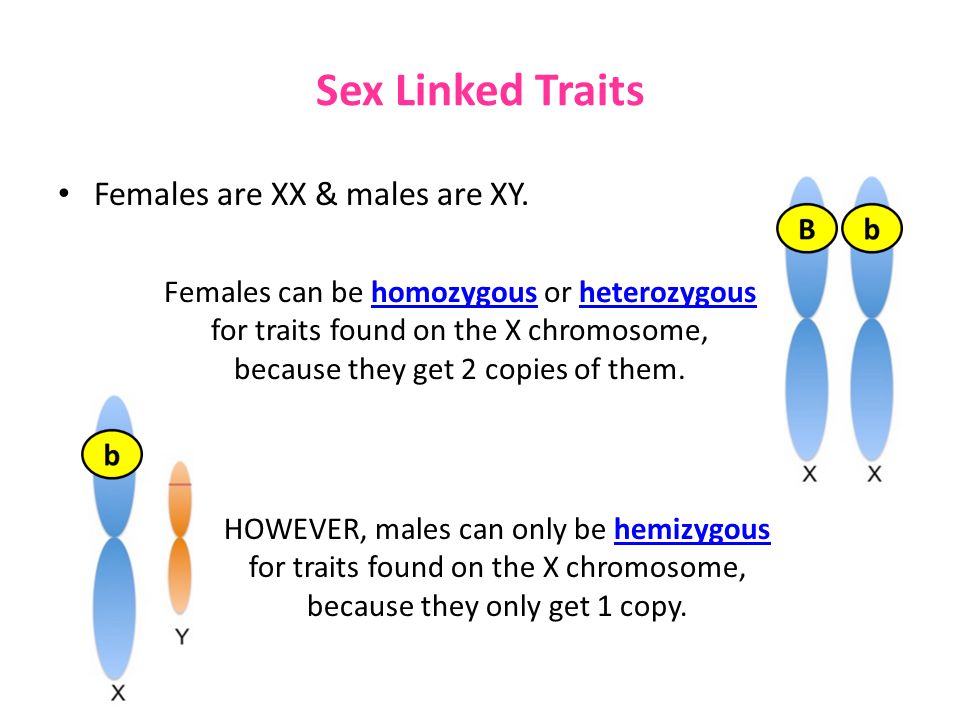
constitutionally hemizygous → if you only have one X chromosome
functionally hemizygous → in females, due to X-inactivation
FALSE: because men only have one Y chromosome therefore they are hemizygous
%%What are examples of patrilineal and matrilineal inheritance? What is heteroplasmy?%%
- patrilineal inheritance: passing down traus from the father to son
- example: Y-linked traits ability to produce sperm
- matrilineal inheritance: passing down the trait from mother to offspring( all sexes)
- example: mitochondrial DNA
- Heteroplasmy: the presence of more than one type of mitochondrial DNA within an individual cells
- due to mutations in mitochondrial DNA during cells division resulting in a mixture of normal and mutated mitochondria DNA \n

- due to mutations in mitochondrial DNA during cells division resulting in a mixture of normal and mutated mitochondria DNA \n
%%Why is the ascertainment bias high for recessive conditions?%%
- Ascertainment bias: when a particular trait is overrepresented in a pedigree ( normally recessive disease but more than 1/4 of people have the disease)
- Disease is more common in family than in population
%%How can two affected parents (of autosomal recessive disease) produce an unaffected child? What is locus heterogeneity? Allelic heterogeneity? Phenotypic heterogeneity? (see also see p. 556 and glossary)%%
- different locus heterogeneity → the mutations from parents are on a different location on chromosome
- Allelic heterogeneity refers to the presence of different mutations within the same gene that can cause the same phenotype
- a different mutations of Cystic fibrosis all cause cystic fibrosis
- Phenotypic heterogeneity refers to the same genotype results in different phenotype
- example muscular dystrophies

%%What is penetrance? Why do we not always see 100% penetrance?%%
- Penetrance: the likelihood of an individual with a particular genetic mutation developing the condition associated with that mutation
- example, allergies
- age-related penetrate due to
- incremental tissue death
- loss of function of the normal protein and toxic accumulation of mutant version( pre-diabetic)
- inability to repair some sort of environmental damage
- second mutation ( two-hit)
- expressivity: the degree of severity or extent of expression
%%What is the difference between a mosaic organism and a chimera? How could each occur?%%
mosaic organisms: mutation during embryonic development resulting in some cell having the mutations while others do not
chimera: when a person has at least two distinct genotypes within their body due to a fusion of two embryos during development
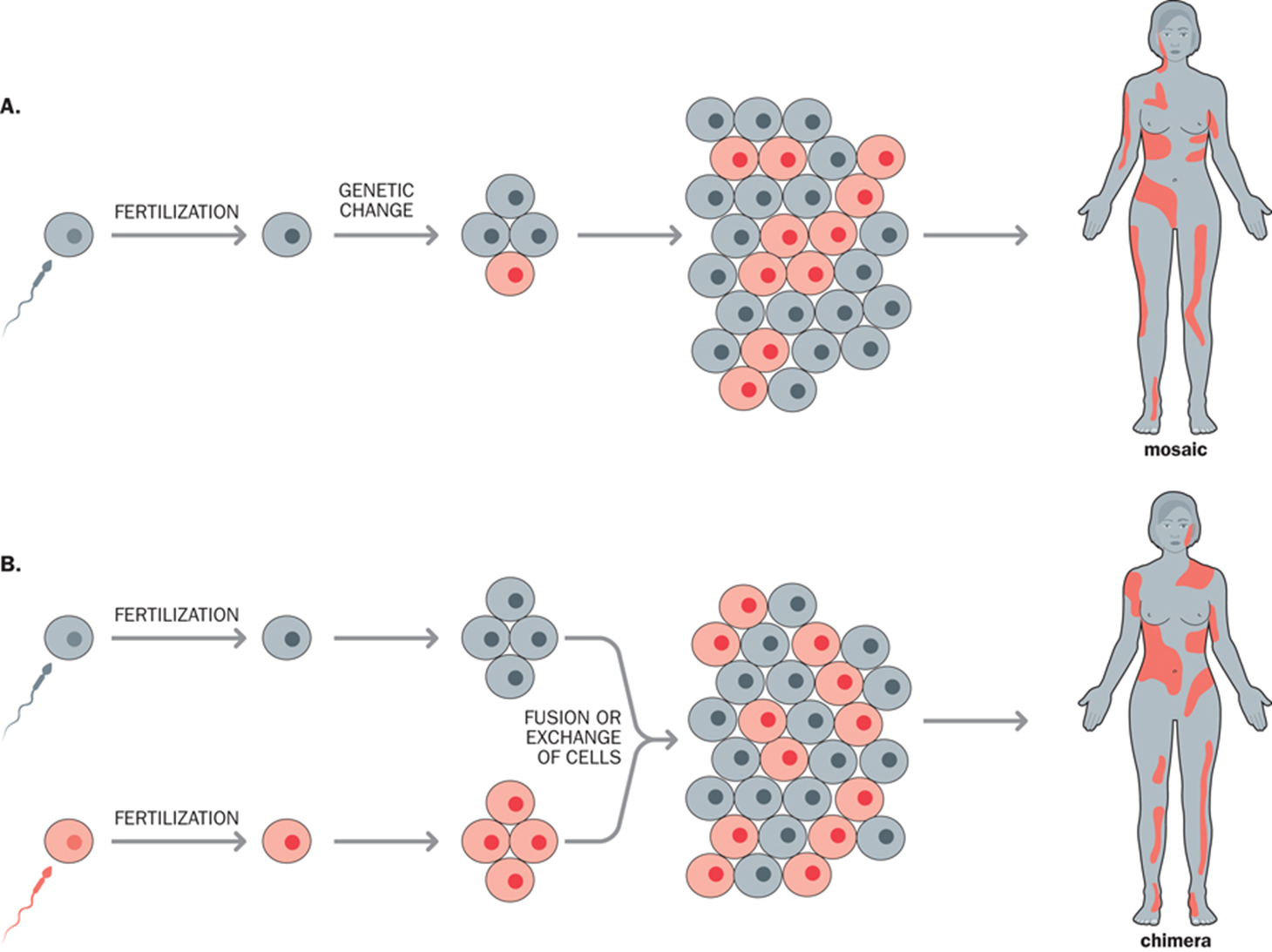
%%What are assumptions made by the Hardy-Weinberg Law?%%
- The law states that under certain conditions, the frequencies of alleles and genotypes in a population will remain constant from generation to generation.
- Allele frequencies are not changing
- The population size is infinite
- Mutations are not occurring
- Mating is random
- There is no purifying selection
- There is no gene flow
%%Be able to explain how genetic drifts, bottle necks, the founder effect influence allele frequencies.%%
geneflow: the transferring of genetic diversity among populations resulting in a change on allele frequencies
genetic drift: the random fluctuations of allel frequencies within a population
bottleneck event: an event that causes a severe reduction in population size and the next generation only has the alleles of the small population
founder effect: a type of genetic drift when small group in populations establishes new population and normally less frequent alleles become more common in new population
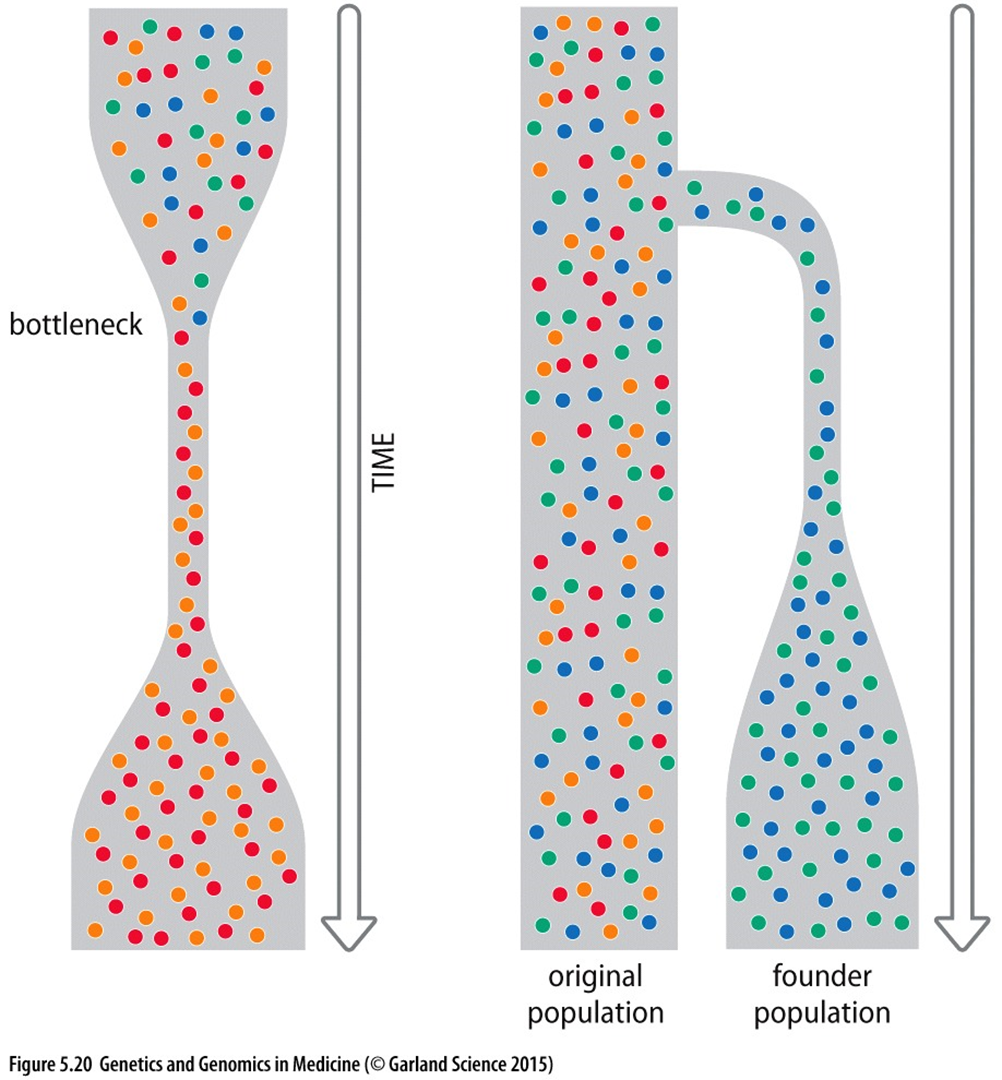
%%Why do some genetic mutations remain in the population? Are high mutation rates and unstable genes enough to explain why harmful disease alleles persist? What is balancing selection?%%
- because mutations are not harmful to current environment or press after giving birth to children
- tumors
- most disease are in ressiev forms → carries
- must mutations are neutral
- some mutations are advantages to enviriment
- malaria and sickle cell anemia
- Balancing selection: a type of natural selection which maintains genetic diversity → heterozygous genotype has higher fitness ( due to better adaptation) than homozygous genotypes leading to maintenance of both alles in population
%%Be able to explain selective sweeps, “hitchhiking alleles” and loss of heterozygosity. (more in 11.4)%%
- selective sweeps: occur when beneficial mutations arise in a population and rapidly increase due to positive selection. While the mutation spreads it sweeps out or eliminates nearby genetic variation
- hitchhiking alleles: when an allele changes frequency not because it itself is under natural selection but because it is near another gene that is undergoing a selective sweep and that is on the same DNA chain.
- loss of heterozygosity: Heterozygosity refers to the presence of different alleles at a given locus or gene in an individual, and loss of heterozygosity occurs when one allele becomes fixed in the population due to positive selection. This results in a loss of genetic variation at the affected locus or gene.

